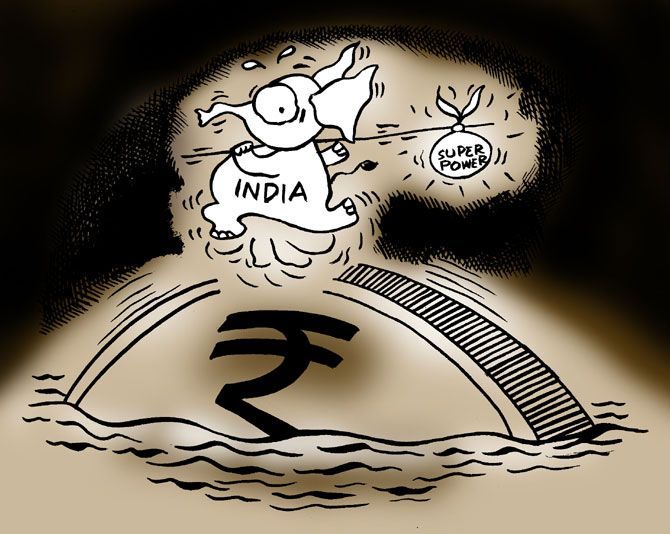RBI is unlikely to stem the slide against the dollar as the greenback is rising rapidly against all currencies in the world.
Anup Roy/Business Standard reports from Mumbai.
Illustration: Uttam Ghosh/Rediff.com
 The rupee touched a record low on Thursday, November 24, but retreated on intervention by the Reserve Bank of India even though the central bank is unlikely to stem the slide against the dollar as the greenback is rising rapidly against all currencies in the world.
The rupee touched a record low on Thursday, November 24, but retreated on intervention by the Reserve Bank of India even though the central bank is unlikely to stem the slide against the dollar as the greenback is rising rapidly against all currencies in the world.
The rupee may touch 70 a dollar or even break the level in the next few days, said most of the 10 currency experts polled by Business Standard on Thursday.
But it would be wrong to assume that the rupee would be staying at those levels for long, they said.
There could be technical correction and rupee may even strengthen from the present level.
The rupee closed at 68.73 to a dollar after touching 68.865, in intra-day trades, a record low of August 28, 2013, when global markets were roiled by the US Federal Reserve's 'taper tantrum.'
This time though, several factors have hit the rupee. Alongside a dollar rally, India has seen over Rs 22,000 crore (Rs 220 billion) flowing out from debt and equity markets in November so far.
Besides, this month also saw $17 billion to $18 billion of outflows due to FCNR(B) deposits and redemption of $1 billion of foreign currency convertible bonds (FCCBs) triggered by falling stock prices.
"However good your macro fundamentals, if the dollar rises you will suffer. You will suffer less maybe, but you cannot escape it," said Jayesh Mehta, head of treasury at Bank of America Merrill Lynch.
The impact of demonetisation on the rupee is indirect and at best a hit on sentiment. On the contrary, the demonetisation drive, being deflationary in nature, can prop up the rupee in the medium term, said Satyajit Kanjilal, managing director of Forexserve.
According to Mecklai Financial CEO Jamal Mecklai, the negative impact of demonetisation has shaved off some of the RBI's credibility and foreign investors won't take it kindly.
"If I have to put money now, I will have to be careful. We can push the button a little bit and say the rupee could reach 71-71.50 in the coming days if we do not receive enough support from the dollar," said Mecklai.
However, the depreciation of the rupee has not surprised everyone.
It was on the offing for some time and was clearly reflected in the overseas non-deliverable forwards (NDF) market that are not regulated by the RBI.
"During our working hours in India, we don't get to see much of a volatility because the RBI intervenes. However, the market is always open, taking cues from the overseas NDF market, and it has been showing sharp depreciation for the rupee for some time," said Abhishek Goenka, head of IFA Global.
"By December, the rupee could weaken to around 69.50, from where it may pull back to 68 on a technical correction," said Mohan Shenoi, head of treasury at Kotak Mahindra Bank.
The real effective exchange rate (REER) is inching up, indicating the rupee is strengthening against currencies of India's trade competitors.
In October the 36-currency REER was 117.12 against 116.35 in September and 116.44 in October 2015.
In a six-currency basket, the REER was 127.65 in October against 124.72 a year ago.
A REER value of 100 is normal, anything above it indicates overvaluation of rupee.
"You need to depreciate to compete with China or South Korea that have let their currencies slide," said Harihar Krishnamurthy, head of treasury at First Rand Bank.
The collapse of the premium in the forwards market has prompted exporters to not sell their dollars.
Banks, under obligation to honour FCNR-related dollar supply, are buying dollars in the spot market and selling them at a future date.
The premium for future dollars has fallen, but the cost of the spot dollar has shot up.
Currency dealers said companies had not hedged because the rupee had showed remarkable strength against its peers in the past 18 months.
"There is a good amount of unhedged position. Now that will change," said Samir Lodha, head of QuantArt Markets Solution.
Currency purge robs advantage given to exports by falling rupee, reports Subhayan Chakraborty/Business Standard.
The rupee, which hit a record low of 68.86 against the US dollar in intra-day deals on Thursday, may not boost exports in November, owing to the effects of demonetisation on domestic industry.
After a rebound in exports in October, exporters feel labour intensive sectors hit hard by demonetisation may push down the export growth rate in November with greater fall in the following months.
On the other hand, the rupee's decline in November has coincided with similar or greater fall in values of currencies from other major emerging markets.
While Thursday saw the rupee surpass its earlier all-time intra-day low of 68.85 hit on August 28, 2013, it has declined by nearly 3% in November.
This is comparable to a 5.6% loss for Malaysia's ringgit, the worst in Asia, and a 3.2% drop in Indonesia's rupiah, data shows.
The Chinese yuan has also hit an 8-1/2 year low.
"This trend virtually wipes all advantages in the trade that a falling rupee might have allowed India," Devendra Pant, Chief Economist at India Ratings said.
This might be crucial to India's export revival as demand conditions always beat currency conditions, he added.
Exports had risen for the second consecutive month in October, growing by 9.59% to $23.51 billion.
This was only the second occasion in the 22 months since December 2014 when a chronic fall in exports started.
This is due to a pickup in global import conditions which saw export figures for most major economies improve.
However, earlier this week, exporters informed Commerce and Industry Minister Nirmala Sitharaman that the government's ban on Rs 500 and Rs 1,000 currency notes would lead to a production decline in the short term.
They also unanimously asked that the weekly withdrawal ceiling of Rs 50,000 allowed to industries be raised to a maximum of Rs 500,000.
The policy has lead to severe difficulties in sourcing input materials, paying informal workers and transporting goods in the past two weeks, exporters said.
"Sectors like textiles, handicrafts, carpets and handlooms source a large part of their input product from the unorganised sector and are therefore facing problems," Director General of Federation of Indian Export Organisations Ajay Sahai said.
The unorganised sector which accounts for a significant 45% of the domestic industry, apart from being the source of input raw materials also acts as a pool of labour for various sectors.
Exporters say the situation is having a grave outcome for employment with large numbers of casual labourers looking at no work as well as downstream industries facing the loss of work.
The issue, Sahai added, was about how long the problem persists, saying that data from the past 15 days suggest exports from sectors like engineering goods and automobiles will hold.
However, sources from both these sectors said under conditions of anonymity that demonetisation is expected to start a ripple effect which will see the export growth rate fall in December onwards when existing stocks ready for shipping start dwindling amidst production shortages.
Economists say external and internal factors to blame for rupee fall, reports Ishan Bakshi/Business Standard.
Economists are divided on whether this rather sudden slide in the rupee has more to do with internal factors or external factors.
"The recent decline in the rupee is largely driven by the strengthening of the dollar which has gained against almost all major currencies," said Madan Sabnavis, chief economist at CARE.
Aditi Nayar, senior economist at ICRA concurred. "The recent weakening of the rupee is primarily a consequence of external factors. The extent of depreciation displayed by the rupee is in the middle of the pack compared to the currencies of other emerging economies. To some extent, the FCNR (foreign currency non-resident) deposit redemption and the recent demonetisation policy by the government may have contributed to this decline," she said.
Since the US election results, the US dollar has strengthened against almost all major currencies.
Among the emerging market currencies, the worst hit has been the Mexican peso which has declined 13% against the dollar since November 8.
The Turkish lira has fallen by eight%, while the Brazilian real and the South African rand are down seven and 7.2% respectively.
Developed countries, too, have seen their currencies fall against the dollar. The euro is down 4.3%, while the Japanese yen is down 7.5%. The pound, though, is marginally up.
The trend appears secular. According to a study by CARE, 11 currencies which had appreciated against the dollar prior to November 8, depreciated sharply thereafter.
But what is interesting to note, as the report points out, is that the 'rupee has not performed too unsatisfactorily as it is at the median change in this set of countries at 2.64%.' The study looks at currency movements till November 18.
It is likely that the strengthening of the dollar reflects the changing perception about the US economy under President-elect Donald Trump.
Economists contend that higher fiscal spending by the US government, as promised by Trump in the run-up to the elections, coupled with lower tax rates, would not only stimulate the US economy but may also prove to be inflationary.
This would put pressure on the US Federal Reserve to raise rates faster than what was anticipated before. Higher interest rates in the US are likely to strengthen the dollar as investment flows back to the US from other economies, especially emerging ones.
But other economists disagree with this prognosis. Soumya Kanti Ghosh, group chief economic advisor at the State Bank of India, said, "Part of the rupee's recent weakness is because of the FCNR redemption. It (the rupee's weakness) seems to be driven by domestic factors. I'm not sure how much it is driven by external factors."
Ghosh's view is based on the fact that during the period of global uncertainty, the rupee was rather steady.
Sound macroeconomic fundamentals -- a declining fiscal deficit and current account deficit and moderating inflation -- were then cited as the reason for the rupee's steady performance.
It is also possible that other internal factors may well have played their part. "There is also some urgency being shown by importers to book their dollars before the month-end which has increased demand for dollars," Sabnavis said.
Though economists expect the volatility to continue till there is greater clarity about Trump's economic strategy, Pronab Sen, former chairman, National Statistical Commission raised an interesting point.
"The real question is what will happen when people start creating black money. Will they decide to keep their cash holding in rupees or will they prefer to switch to the dollar?" he asked.











